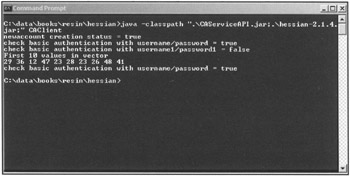Mobile Hessian
|
Client for the New Service
Now that your new authentication service is up and running, it's time to write a client to use the provided methods. The code in Listing 9.5 shows how to access the methods using the same techniques found in the BasicAPI client.
Listing 9.5: CAService client code.
import com.caucho.hessian.client.HessianProxyFactory; import java.net.MalformedURLException; import java.util.Vector; import authentication.CAServiceAPI; public class CAClient { static String url = "http://localhost:8080/hessian/authentication/CAService"; public static void main(String[] args) { CAServiceAPI basic = null; HessianProxyFactory factory = new HessianProxyFactory(); try { basic = (CAServiceAPI) factory.create(CAServiceAPI.class, url); } catch (MalformedURLException e) { System.out.println("Bad URL"); } if (basic != null) { try { System.out.println("newaccount creation status = " + basic.createNewAccount("username", "password")); System.out.println("check basic authentication with username/password = " + basic.baseAuthenticate("username", "password")); System.out.println("check basic authentication with usernamel/passwordl = " + basic.baseAuthenticate("usernamel", "passwordl")); Vector vec = (Vector)basic.provideCertificate("username", "password"); System.out.println("First 10 values in vector"); for(int i=0;i<10;i++) System.out.print(vec.elementAt(i) + " "); System.out.println(""); System.out.println("check basic authentication with username/password = " + basic.secureAuthentication("username", "password", vec)); } catch (Exception e) { e.printStackTrace(); } } } } As you look through the code in Listing 9.5, you will find that it looks like the BasicAPI client, except instead of using BasicAPI as the interface class, it uses
CAServiceAPI instead. The code in the client exercises all the methods of the authentication service. When you compile and execute the client, it is imperative that both the hessian-3.0.2.jar and the CAServiceAPI.jar files be found in the classpath. If the JAR files aren't in the classpath, the client will produce an error. Figure 9.2 shows the output from an execution of the client code.

Figure 9.2: CACIient execution output.
|
EAN: 2147483647
Pages: 180